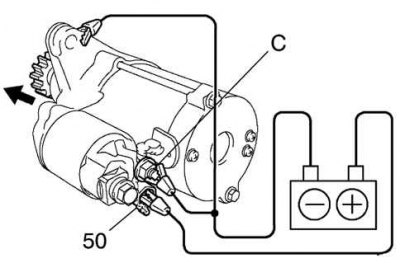Attention! The check should be carried out in the interval of 3–5 s in order to avoid damage to the stator winding.
Checking the retracting winding of the traction relay
Disconnect the wire from the starter terminal «WITH».

Pic. 7.36. Connecting the battery wire to the traction relay terminals
Connect the wires from the battery to the terminals of the traction relay, as shown in Figure 7.36.
Make sure the freewheel gear is out.
If the overrunning clutch drive gear does not move forward, replace the traction relay.
Checking the holding winding

Pic. 7.37. Checking the holding winding
With the connections made in the order shown in the previous check and the freewheel drive gear extended, disconnect the negative wire from the «WITH» (pic. 7.37).
Make sure the pinion gear stays extended.
If the drive gear returns inside, then replace the traction relay.
Overrunning Clutch Drive Gear Return Check

Pic. 7.38. Overrunning Clutch Drive Gear Return Check
Disconnect the negative wire from the traction relay housing (pic. 7.38).
Make sure the freewheel drive gear is retracted inward.
If the freewheel drive gear has not retracted, replace the traction relay assembly.
Checking starter operation without load

Pic. 7.39. Checking starter operation without load
Connect the wires from the battery and from the ammeter to the starter, as shown in Figure 7.39.
Check that the starter armature rotates evenly and the freewheel drive gear is extended. Measure the current with an ammeter.
Rated current at 11.5 V: 90 A.
